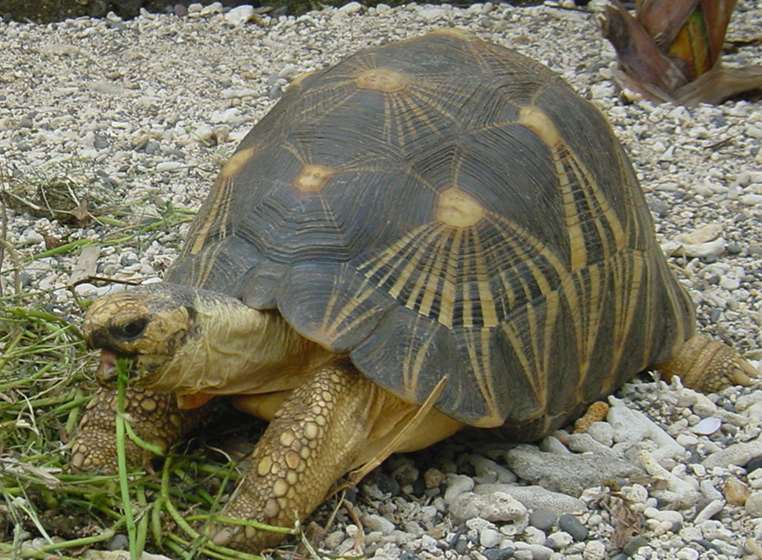- Geochelone
Taxobox |

image_width = 250px
image_caption = "Geochelone radiata "
name = "Geochelone"
regnum =Animal ia
phylum =Chordata
classis = Sauropsida
ordo =Testudines
subordo =Cryptodira
familia =Testudinidae
genus = "Geochelone"
genus_authority = Fitzinger,1835
subdivision_ranks = Species
subdivision ="G. carbonaria"
"G. chilensis"
"G. denticulata"
"G. elegans"
"G. gigantea"
"G. nigra"
"G. pardalis"
"G. platynota"
"G. radiata"
"G. sulcata"
"G. yniphora""Geochelone" is a
genus oftortoise s.Geochelone Tortoises, which are also known as "geoclelone tortoises" or "typical tortoises", can be found in
Africa , America,Asia , and several Oceanic islands. They primarily eatplant s, specifically dark greens. Measured by the length of their shell, the species in this genus are some of the largestturtle s in the world, especially theGalápagos tortoise ("G. nigra"), which can get as long as 6 feet (1.80 meters). The genus consists of the following 12 species:
*Red-footed tortoise ("G. carbonaria")
*Chaco tortoise ("G. chilensis")
*South American yellow-footed tortoise ("G. denticulata")
*Indian Star Tortoise ("G. elegans")
*Aldabra Giant Tortoise ("G. gigantea")
*Galápagos tortoise ("G. nigra")
*Leopard Tortoise ("G. pardalis")
*Burmese Star Tortoise ("G. platynota")
*Radiated Tortoise ("G. radiata")
*African Spurred Tortoise ("G. sulcata")
*Angonoka or Angulated Tortoise ("G. yniphora")A recent comparative genetic analysis has indicated that this taxon is "polyphyletic, representing at least four independent
clade s".cite journal
last = Le
first = M.
authorlink =
coauthors = Raxworthy, C. J.; McCord, W. P.; Mertz, L.
title = A molecular phylogeny of tortoises (Testudines: Testudinidae} based on mitochondrial and nuclear genes
journal = Molecular Phylogenetics and Evolution
volume = 40
issue =
pages = 517-531
publisher =
location =
date = 2006-05-05
url = http://www.sciencedirect.com/science?_ob=ArticleURL&_udi=B6WNH-4JWFGYC-1&_user=4430&_rdoc=1&_fmt=&_orig=search&_sort=d&view=c&_acct=C000059594&_version=1&_urlVersion=0&_userid=4430&md5=17737ababb8f6b572a3a44a520001dc6
doi = 10.1016/j.ympev.2006.03.003
id =
accessdate = ]South America n members of "Geochelone" are actually most closely related to African hingeback tortoises."Self-righting" shell
The form of the shell of the Indian Star Tortoise ("Geochelone elegans") resembles a
gömböc , allowing it to turn over when lying upside down very easily.References
*de
*" [http://www.itis.gov/servlet/SingleRpt/SingleRpt?search_topic=TSN&search_value=173853 Geochelone Report] " inIntegrated Taxonomic Information System . Retrieved January 12, 2008.External links
*ARKive - [http://www.arkive.org/species/GES/reptiles/Geochelone_chilensis/ images and movies of the Chaco tortoise "(Geochelone chilensis)"] [http://home.earthlink.net/~rednine/sulcatacare.html]
Wikimedia Foundation. 2010.
